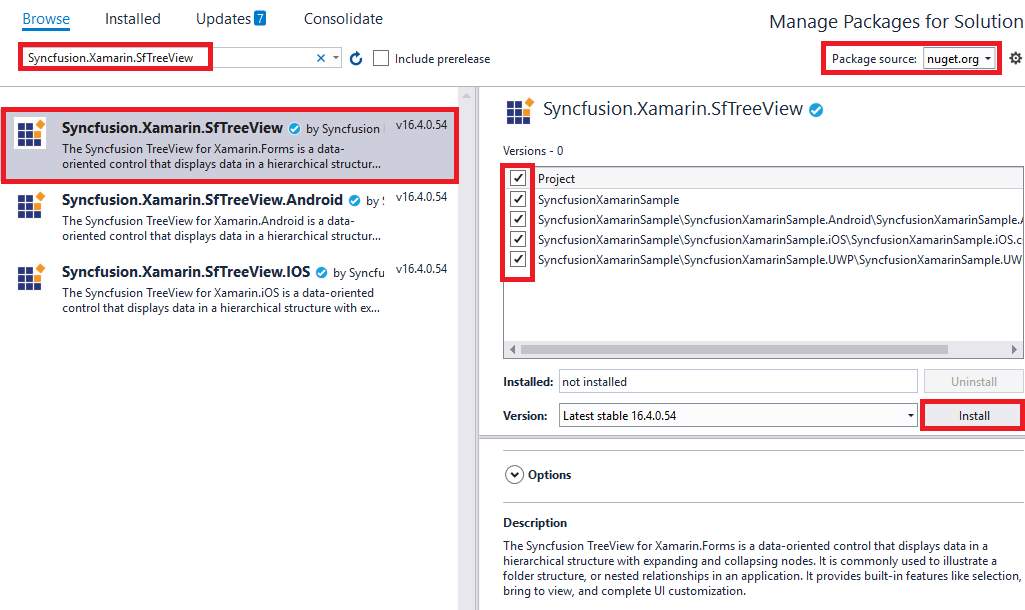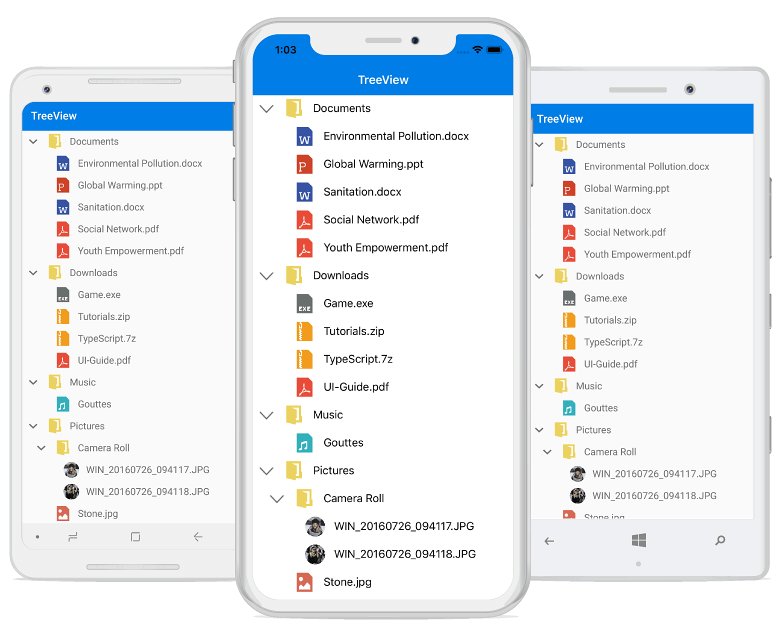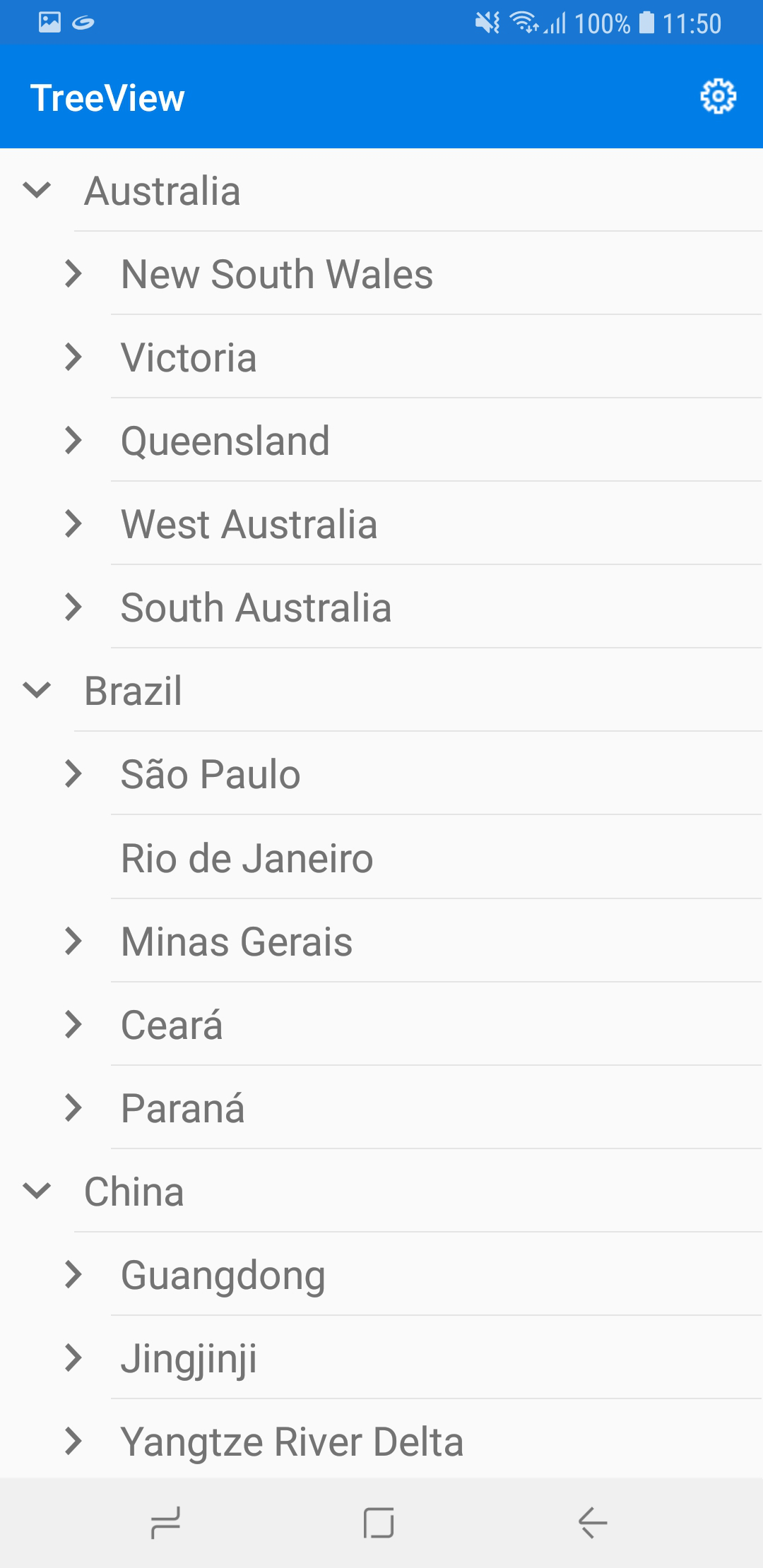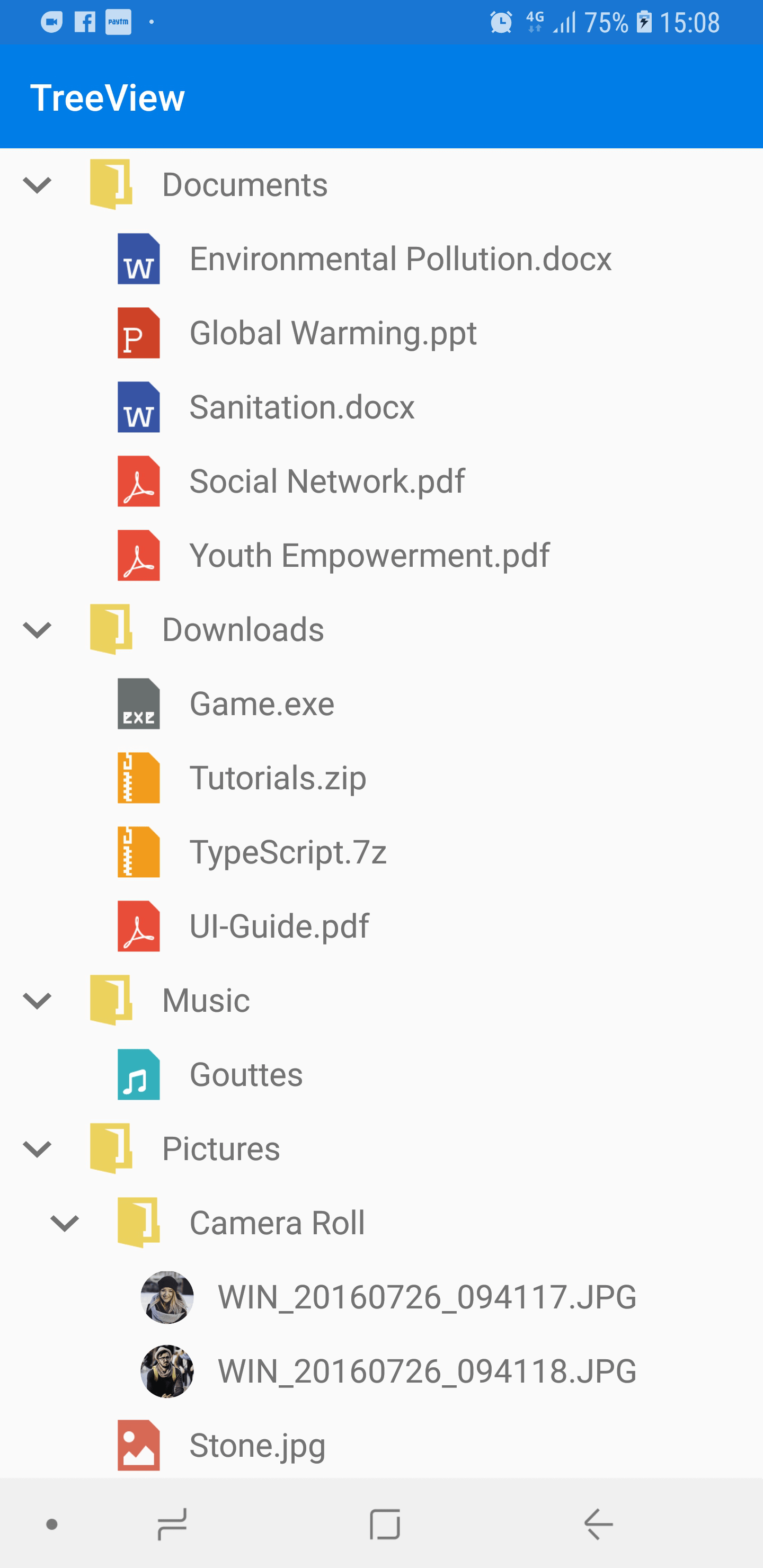Getting Started with Xamarin TreeView (SfTreeView)
21 Nov 202424 minutes to read
This section provides a quick overview for getting started with the TreeView for Xamarin.Forms. Walk through the entire process of creating an app with TreeView.
Assembly Deployment
After installing Essential Studio® for Xamarin, you can find all the required assemblies in the installation folders, {Syncfusion Essential Studio Installed location} \Essential Studio\{Version #}\Xamarin\lib.
E.g.: C:\Program Files (x86) \Syncfusion\Essential Studio\19.1.0.54\Xamarin\lib
Refer control dependencies section to get the list of assemblies or NuGet package needs to be added as reference to use the TreeView control in any application.
NOTE
Assemblies can be found in unzipped package location(Documents/Syncfusion/{Version #}/Xamarin/lib) in Mac.
Adding SfTreeView reference
You can add SfTreeView reference using one of the following methods:
Method 1: Adding SfTreeView reference from nuget.org
Syncfusion Xamarin components are available in nuget.org. To add SfTreeView to your project, open the NuGet package manager in Visual Studio, search for Syncfusion.Xamarin.SfTreeView, and then install it.

NOTE
Install the same version of SfTreeView NuGet in all the projects.
Method 2: Adding SfTreeView reference from toolbox
Syncfusion also provides Xamarin Toolbox. Using this toolbox, you can drag the SfTreeView control to the XAML page. It will automatically install the required NuGet packages and add the namespace to the page. To install Syncfusion Xamarin Toolbox, refer to Toolbox.
Method 3: Adding SfTreeView assemblies manually from the installed location
If you prefer to manually reference the assemblies instead referencing from NuGet, add the following assemblies in respective projects.
Location: {Installed location}/{version}/Xamarin/lib
| PCL | Syncfusion.SfTreeView.XForms.dll Syncfusion.Core.XForms.dll Syncfusion.Licensing.dll |
| Android | Syncfusion.GridCommon.Portable.dll Syncfusion.SfTreeView.XForms.Android.dll Syncfusion.SfTreeView.XForms.dll Syncfusion.Core.XForms.dll Syncfusion.Core.XForms.Android.dll Syncfusion.Licensing.dll |
| iOS | Syncfusion.GridCommon.Portable.dll Syncfusion.SfTreeView.XForms.iOS.dll Syncfusion.SfTreeView.XForms.dll Syncfusion.Core.XForms.dll Syncfusion.Core.XForms.iOS.dll Syncfusion.Licensing.dll |
| UWP | Syncfusion.GridCommon.Portable.dll Syncfusion.SfTreeView.XForms.UWP.dll Syncfusion.SfTreeView.XForms.dll Syncfusion.Core.XForms.dll Syncfusion.Core.XForms.UWP.dll Syncfusion.Licensing.dll |
NOTE
To know more about obtaining our components, refer to these links for Mac and Windows.
IMPORTANT
Starting with v16.2.0.x, if you reference Syncfusion assemblies from the trial setup or from the NuGet feed, you also have to include a license key in your projects. Please refer to Syncfusion license key to know about registering Syncfusion license key in your Xamarin application to use our components.
Launching the TreeView on Each Platform
To use this control inside an application, each platform application must initialize the TreeView renderer. This initialization step varies from platform to platform, and is discussed in the following sections:
Android
The Android launches the TreeView without any initialization and is enough to only initialize the Xamarin.Forms Framework to launch the application.
NOTE
After adding the reference, an additional step is required to initialize the renderer for iOS and UWP projects. If you are adding the references from toolbox, this step is not needed.
iOS
To launch the TreeView in iOS, call the SfTreeViewRenderer.Init() in the FinishedLaunching overridden method of the AppDelegate class after the Xamarin.Forms Framework initialization, and before the LoadApplication is called as demonstrated in the following code example:
public override bool FinishedLaunching(UIApplication app, NSDictionary options)
{
…
global::Xamarin.Forms.Forms.Init ();
SfTreeViewRenderer.Init();
LoadApplication (new App ());
…
}Universal Windows Platform (UWP)
To launch the TreeView in UWP, call the SfTreeViewRenderer.Init() in the MainPage constructor before the LoadApplication is called as demonstrated in the following code example:
public MainPage()
{
…
SfTreeViewRenderer.Init();
LoadApplication (new App ());
…
}ReleaseMode Issue in UWP Platform
The known Framework issue in UWP platform is the custom controls will not render when deployed the application in Release Mode.
The above problem can be resolved by initializing the TreeView assemblies in App.xaml.cs in UWP project as in the following code snippet:
// In App.xaml.cs
protected override void OnLaunched(LaunchActivatedEventArgs e)
{
…
rootFrame.NavigationFailed += OnNavigationFailed;
// you'll need to add `using System.Reflection;`
List<Assembly> assembliesToInclude = new List<Assembly>();
//Now, add all the assemblies your app uses
assembliesToInclude.Add(typeof(SfTreeViewRenderer).GetTypeInfo().Assembly);
// replaces Xamarin.Forms.Forms.Init(e);
Xamarin.Forms.Forms.Init(e, assembliesToInclude);
…
}Create a tree view
This section explains how to create a TreeView and configure it. The TreeView control can be configured entirely in C# code, or by using XAML markup. This is how the control will look like on iOS, Android, and Windows devices.

In this walk through, you will create a new application with the TreeView that includes the following topics:
- Creating the project
- Adding tree view in Xamarin.Forms
- Populating Nodes without data source - Unbound Mode
- Creating Data Model
- Bind to a hierarchical data source - Bound Mode
- Creating hierarchical Data Model
- Bind to a Hierarchy Property Descriptors data source - Bound Mode
- Defining a template to expander and content view
- Interacting with a tree view
- Selection
Creating the Project
Create a new blank (Xamarin.Forms.NET Standard) application in Xamarin Studio or Visual Studio for Xamarin.Forms.
Adding the tree view in Xamarin.Forms
- Add the required assembly references to the corresponding projects as discussed in the Assembly deployment section.
- Import the SfTreeView control namespace Syncfusion.XForms.TreeView.
- Set the TreeView control to the ContentPage.
<?xml version="1.0" encoding="utf-8" ?>
<ContentPage xmlns="http://xamarin.com/schemas/2014/forms"
xmlns:x="http://schemas.microsoft.com/winfx/2009/xaml"
xmlns:syncfusion="clr-namespace:Syncfusion.XForms.TreeView;assembly=Syncfusion.SfTreeView.XForms"
xmlns:local="clr-namespace:GettingStarted;assembly=GettingStarted"
x:Class="GettingStarted.MainPage">
<syncfusion:SfTreeView x:Name="treeView" />
</ContentPage>using Syncfusion.XForms.TreeView;
using Xamarin.Forms;
namespace GettingStarted
{
public class App : Application
{
SfTreeView treeView;
public App()
{
treeView = new SfTreeView();
MainPage = new ContentPage { Content = treeView};
}
}
}Populating Nodes without data source - Unbound Mode
You can create and manage the TreeViewNode objects by yourself to display the data in a hierarchical view. To create a tree view, you can use a TreeView control and a hierarchy of TreeViewNode objects. You can create the node hierarchy by adding one or more root nodes to the TreeView control’s Nodes collection. Each TreeViewNode can then have more nodes added to its Children collection. You can nest the tree view nodes to any depth you need.
Important
ItemsSource is an alternative mechanism toNodesfor putting content into the TreeView control. You cannot set bothItemsSourceandNodesat the same time. When you useItemsSource, nodes created for you internally, but you cannot access them fromNodesproperty.
<?xml version="1.0" encoding="utf-8" ?>
<ContentPage xmlns="http://xamarin.com/schemas/2014/forms"
xmlns:x="http://schemas.microsoft.com/winfx/2009/xaml"
xmlns:syncfusion="clr-namespace:Syncfusion.XForms.TreeView;assembly=Syncfusion.SfTreeView.XForms"
xmlns:treeviewengine="clr-namespace:Syncfusion.TreeView.Engine;assembly=Syncfusion.SfTreeView.XForms"
xmlns:local="clr-namespace:GettingStarted;assembly=GettingStarted"
x:Class="GettingStarted.MainPage">
<ContentPage.Content>
<syncfusion:SfTreeView x:Name="treeView">
<syncfusion:SfTreeView.Nodes>
<treeviewengine:TreeViewNode Content="Australia">
<treeviewengine:TreeViewNode.ChildNodes>
<treeviewengine:TreeViewNode Content="New South Wales">
<treeviewengine:TreeViewNode.ChildNodes>
<treeviewengine:TreeViewNode Content="Sydney"/>
</treeviewengine:TreeViewNode.ChildNodes>
</treeviewengine:TreeViewNode>
</treeviewengine:TreeViewNode.ChildNodes>
</treeviewengine:TreeViewNode>
<treeviewengine:TreeViewNode Content="United States of America">
<treeviewengine:TreeViewNode.ChildNodes>
<treeviewengine:TreeViewNode Content="New York"/>
<treeviewengine:TreeViewNode Content="California">
<treeviewengine:TreeViewNode.ChildNodes>
<treeviewengine:TreeViewNode Content="San Francisco"/>
</treeviewengine:TreeViewNode.ChildNodes>
</treeviewengine:TreeViewNode>
</treeviewengine:TreeViewNode.ChildNodes>
</treeviewengine:TreeViewNode>
</syncfusion:SfTreeView.Nodes>
</syncfusion:SfTreeView>
</ContentPage.Content>
</ContentPage>using Syncfusion.TreeView.Engine;
using Syncfusion.XForms.TreeView;
using Xamarin.Forms;
namespace GettingStarted
{
public class App : Application
{
SfTreeView treeView;
public App()
{
treeView = new SfTreeView();
var australia = new TreeViewNode() { Content = "Australia" };
var _NSW = new TreeViewNode() { Content = "New South Wales" };
var Sydney = new TreeViewNode() { Content = "Sydney" };
australia.ChildNodes.Add(_NSW);
_NSW.ChildNodes.Add(Sydney);
var usa = new TreeViewNode() { Content = "United States of America" };
var newYork = new TreeViewNode() { Content = "New York," };
var California = new TreeViewNode() { Content = "California" };
var SanFrancisco = new TreeViewNode() { Content = "San Francisco" };
usa.ChildNodes.Add(newYork);
usa.ChildNodes.Add(California);
California.ChildNodes.Add(SanFrancisco);
treeView.Nodes.Add(australia);
treeView.Nodes.Add(usa);
MainPage = new ContentPage { Content = treeView};
}
}
}Download the entire source code from GitHub here.

Creating Data Model for the tree view
Create a data model to bind it to the control.
Create a simple data source as shown in the following code example in a new class file, and save it as FileManager.cs file:
public class FileManager : INotifyPropertyChanged
{
private string itemName;
private ImageSource imageIcon;
private ObservableCollection<FileManager> subFiles;
public ObservableCollection<FileManager> SubFiles
{
get { return subFiles; }
set
{
subFiles = value;
RaisedOnPropertyChanged("SubFiles");
}
}
public string ItemName
{
get { return itemName; }
set
{
itemName = value;
RaisedOnPropertyChanged("ItemName");
}
}
public ImageSource ImageIcon
{
get { return imageIcon; }
set
{
imageIcon = value;
RaisedOnPropertyChanged("ImageIcon");
}
}
public event PropertyChangedEventHandler PropertyChanged;
public void RaisedOnPropertyChanged(string _PropertyName)
{
if (PropertyChanged != null)
{
PropertyChanged(this, new PropertyChangedEventArgs(_PropertyName));
}
}
}NOTE
If you want your data model to respond to property changes, then implement
INotifyPropertyChangedinterface in your model class.
Create a model repository class with ImageNodeInfo collection property initialized with required number of data objects in a new class file as shown in the following code example, and save it as FileManagerViewModel.cs file:
public class FileManagerViewModel
{
private ObservableCollection<FileManager> imageNodeInfo;
public FileManagerViewModel()
{
GenerateSource();
}
public ObservableCollection<FileManager> ImageNodeInfo
{
get { return imageNodeInfo; }
set { this.imageNodeInfo = value; }
}
private void GenerateSource()
{
var nodeImageInfo = new ObservableCollection<FileManager>();
Assembly assembly = typeof(GettingStated).GetTypeInfo().Assembly;
var doc = new FileManager() { ItemName = "Documents", ImageIcon = ImageSource.FromResource("GettingStartedBound.Icons.treeview_folder.png", assembly) };
var download = new FileManager() { ItemName = "Downloads", ImageIcon = ImageSource.FromResource("GettingStartedBound.Icons.treeview_folder.png", assembly) };
var mp3 = new FileManager() { ItemName = "Music", ImageIcon = ImageSource.FromResource("GettingStartedBound.Icons.treeview_folder.png", assembly) };
var pictures = new FileManager() { ItemName = "Pictures", ImageIcon = ImageSource.FromResource("GettingStartedBound.Icons.treeview_folder.png", assembly) };
var video = new FileManager() { ItemName = "Videos", ImageIcon = ImageSource.FromResource("GettingStartedBound.Icons.treeview_folder.png", assembly) };
var pollution = new FileManager() { ItemName = "Environmental Pollution.docx", ImageIcon = ImageSource.FromResource("GettingStartedBound.Icons.treeview_word.png", assembly) };
var globalWarming = new FileManager() { ItemName = "Global Warming.ppt", ImageIcon = ImageSource.FromResource("GettingStartedBound.Icons.treeview_ppt.png", assembly) };
var sanitation = new FileManager() { ItemName = "Sanitation.docx", ImageIcon = ImageSource.FromResource("GettingStartedBound.Icons.treeview_word.png", assembly) };
var socialNetwork = new FileManager() { ItemName = "Social Network.pdf", ImageIcon = ImageSource.FromResource("GettingStartedBound.Icons.treeview_pdf.png", assembly) };
var youthEmpower = new FileManager() { ItemName = "Youth Empowerment.pdf", ImageIcon = ImageSource.FromResource("GettingStartedBound.Icons.treeview_pdf.png", assembly) };
var games = new FileManager() { ItemName = "Game.exe", ImageIcon = ImageSource.FromResource("GettingStartedBound.Icons.treeview_exe.png", assembly) };
var tutorials = new FileManager() { ItemName = "Tutorials.zip", ImageIcon = ImageSource.FromResource("GettingStartedBound.Icons.treeview_zip.png", assembly) };
var TypeScript = new FileManager() { ItemName = "TypeScript.7z", ImageIcon = ImageSource.FromResource("GettingStartedBound.Icons.treeview_zip.png", assembly) };
var uiGuide = new FileManager() { ItemName = "UI-Guide.pdf", ImageIcon = ImageSource.FromResource("GettingStartedBound.Icons.treeview_pdf.png", assembly) };
var song = new FileManager() { ItemName = "Goutiest", ImageIcon = ImageSource.FromResource("GettingStartedBound.Icons.treeview_mp3.png", assembly) };
var camera = new FileManager() { ItemName = "Camera Roll", ImageIcon = ImageSource.FromResource("GettingStartedBound.Icons.treeview_folder.png", assembly) };
var stone = new FileManager() { ItemName = "Stone.jpg", ImageIcon = ImageSource.FromResource("GettingStartedBound.Icons.treeview_png.png", assembly) };
var wind = new FileManager() { ItemName = "Wind.jpg", ImageIcon = ImageSource.FromResource("GettingStartedBound.Icons.treeview_png.png", assembly) };
var img0 = new FileManager() { ItemName = "WIN_20160726_094117.JPG", ImageIcon = ImageSource.FromResource("GettingStartedBound.Icons.treeview_img0.png", assembly) };
var img1 = new FileManager() { ItemName = "WIN_20160726_094118.JPG", ImageIcon = ImageSource.FromResource("GettingStartedBound.Icons.treeview_img1.png", assembly) };
var video1 = new FileManager() { ItemName = "Naturals.mp4", ImageIcon = ImageSource.FromResource("GettingStartedBound.Icons.treeview_video.png", assembly) };
var video2 = new FileManager() { ItemName = "Wild.mpg", ImageIcon = ImageSource.FromResource("GettingStartedBound.Icons.treeview_video.png", assembly) };
doc.SubFiles = new ObservableCollection<FileManager>
{
pollution,
globalWarming,
sanitation,
socialNetwork,
youthEmpower
};
download.SubFiles = new ObservableCollection<FileManager>
{
games,
tutorials,
TypeScript,
uiGuide
};
mp3.SubFiles = new ObservableCollection<FileManager>
{
song
};
pictures.SubFiles = new ObservableCollection<FileManager>
{
camera,
stone,
wind
};
camera.SubFiles = new ObservableCollection<FileManager>
{
img0,
img1
};
video.SubFiles = new ObservableCollection<FileManager>
{
video1,
video2
};
nodeImageInfo.Add(doc);
nodeImageInfo.Add(download);
nodeImageInfo.Add(mp3);
nodeImageInfo.Add(pictures);
nodeImageInfo.Add(video);
imageNodeInfo = nodeImageInfo;
}
}Bind to a hierarchical data source - Bound Mode
You can create a tree view by binding the ItemsSource to a hierarchical data source. To create a tree view using data binding, set a hierarchical collection to the ItemsSource property. Then in the ItemTemplate and ExpanderTemplate, set the child items collection to the ItemsSource property.
Important
ItemsSourceis an alternative mechanism to Nodes for putting content into the TreeView control. You cannot set bothItemsSourceandNodesat the same time. When you useItemsSource, nodes created for you internally, but you cannot access them fromNodesproperty.
<?xml version="1.0" encoding="utf-8" ?>
<ContentPage xmlns="http://xamarin.com/schemas/2014/forms"
xmlns:x="http://schemas.microsoft.com/winfx/2009/xaml"
xmlns:syncfusion="clr-namespace:Syncfusion.XForms.TreeView;assembly=Syncfusion.SfTreeView.XForms"
xmlns:treeviewengine="clr-namespace:Syncfusion.TreeView.Engine;assembly=Syncfusion.SfTreeView.XForms"
xmlns:local="clr-namespace:GettingStarted;assembly=GettingStarted"
x:Class="GettingStarted.MainPage">
<ContentPage.BindingContext>
<local:FileManagerViewModel x:Name="viewModel"></local:FileManagerViewModel>
</ContentPage.BindingContext>
<ContentPage.Content>
<syncfusion:SfTreeView x:Name="treeView" ChildPropertyName="SubFiles" ItemsSource="{Binding ImageNodeInfo}">
</syncfusion:SfTreeView>
</ContentPage.Content>
</ContentPage>SfTreeView treeView = new SfTreeView();
FileManagerViewModel viewModel = new FileManagerViewModel ();
treeView.ItemsSource = viewModel.ImageNodeInfo;
MainPage = new ContentPage { Content = treeView };Creating hierarchical Data Model for tree view
Create an hierarchical data model to bind it to the control.
Create a simple hierarchical data source as shown in the following code example in a new class file, and save it as FileManager.cs file.
public class Folder : INotifyPropertyChanged
{
private string fileName;
private ImageSource imageIcon;
private ObservableCollection<File> files;
public Folder()
{
}
public ObservableCollection<File> Files
{
get { return files; }
set
{
files = value;
RaisedOnPropertyChanged("SubFiles");
}
}
public string FileName
{
get { return fileName; }
set
{
fileName = value;
RaisedOnPropertyChanged("FileName");
}
}
public ImageSource ImageIcon
{
get { return imageIcon; }
set
{
imageIcon = value;
RaisedOnPropertyChanged("ImageIcon");
}
}
public event PropertyChangedEventHandler PropertyChanged;
public void RaisedOnPropertyChanged(string _PropertyName)
{
if (PropertyChanged != null)
{
PropertyChanged(this, new PropertyChangedEventArgs(_PropertyName));
}
}
}
public class File : INotifyPropertyChanged
{
private string fileName;
private ImageSource imageIcon;
private ObservableCollection<SubFile> subFiles;
public File()
{
}
public ObservableCollection<SubFile> SubFiles
{
get { return subFiles; }
set
{
subFiles = value;
RaisedOnPropertyChanged("SubFiles");
}
}
public string FileName
{
get { return fileName; }
set
{
fileName = value;
RaisedOnPropertyChanged("FileName");
}
}
public ImageSource ImageIcon
{
get { return imageIcon; }
set
{
imageIcon = value;
RaisedOnPropertyChanged("ImageIcon");
}
}
public event PropertyChangedEventHandler PropertyChanged;
public void RaisedOnPropertyChanged(string _PropertyName)
{
if (PropertyChanged != null)
{
PropertyChanged(this, new PropertyChangedEventArgs(_PropertyName));
}
}
}
public class SubFile : INotifyPropertyChanged
{
private string fileName;
private ImageSource imageIcon;
public SubFile()
{
}
public string FileName
{
get { return fileName; }
set
{
fileName = value;
RaisedOnPropertyChanged("FolderName");
}
}
public ImageSource ImageIcon
{
get { return imageIcon; }
set
{
imageIcon = value;
RaisedOnPropertyChanged("ImageIcon");
}
}
public event PropertyChangedEventHandler PropertyChanged;
public void RaisedOnPropertyChanged(string _PropertyName)
{
if (PropertyChanged != null)
{
PropertyChanged(this, new PropertyChangedEventArgs(_PropertyName));
}
}
}NOTE
If you need your hierarchical data model to respond to property changes, then implement the
INotifyPropertyChangedinterface in your model class.
Create a model repository class with ImageNodeInfo collection property initialized with required number of data objects in a new class file as shown in the following code example, and save it as FileManagerViewModel.cs file:
public class FileManagerViewModel
{
public ObservableCollection<Folder> Folders { get; set; }
public ObservableCollection<File> Files { get; set; }
public ObservableCollection<SubFile> SubFiles { get; set; }
public FileManagerViewModel()
{
this.Folders = GetFiles();
}
private ObservableCollection<Folder> GetFiles()
{
var nodeImageInfo = new ObservableCollection<Folder>();
Assembly assembly = typeof(NodeWithImage).GetTypeInfo().Assembly;
var doc = new Folder() { FileName = "Documents", ImageIcon = ImageSource.FromResource("SampleBrowser.SfTreeView.Icons.NodeWithImage.treeview_folder.png", assembly) };
var download = new Folder() { FileName = "Downloads", ImageIcon = ImageSource.FromResource("SampleBrowser.SfTreeView.Icons.NodeWithImage.treeview_folder.png", assembly) };
var mp3 = new Folder() { FileName = "Music", ImageIcon = ImageSource.FromResource("SampleBrowser.SfTreeView.Icons.NodeWithImage.treeview_folder.png", assembly) };
var pictures = new Folder() { FileName = "Pictures", ImageIcon = ImageSource.FromResource("SampleBrowser.SfTreeView.Icons.NodeWithImage.treeview_folder.png", assembly) };
var video = new Folder() { FileName = "Videos", ImageIcon = ImageSource.FromResource("SampleBrowser.SfTreeView.Icons.NodeWithImage.treeview_folder.png", assembly) };
var pollution = new File() { FileName = "Environmental Pollution.docx", ImageIcon = ImageSource.FromResource("SampleBrowser.SfTreeView.Icons.NodeWithImage.treeview_word.png", assembly) };
var globalWarming = new File() { FileName = "Global Warming.ppt", ImageIcon = ImageSource.FromResource("SampleBrowser.SfTreeView.Icons.NodeWithImage.treeview_ppt.png", assembly) };
var sanitation = new File() { FileName = "Sanitation.docx", ImageIcon = ImageSource.FromResource("SampleBrowser.SfTreeView.Icons.NodeWithImage.treeview_word.png", assembly) };
var socialNetwork = new File() { FileName = "Social Network.pdf", ImageIcon = ImageSource.FromResource("SampleBrowser.SfTreeView.Icons.NodeWithImage.treeview_pdf.png", assembly) };
var youthEmpower = new File() { FileName = "Youth Empowerment.pdf", ImageIcon = ImageSource.FromResource("SampleBrowser.SfTreeView.Icons.NodeWithImage.treeview_pdf.png", assembly) };
var games = new File() { FileName = "Game.exe", ImageIcon = ImageSource.FromResource("SampleBrowser.SfTreeView.Icons.NodeWithImage.treeview_exe.png", assembly) };
var tutorials = new File() { FileName = "Tutorials.zip", ImageIcon = ImageSource.FromResource("SampleBrowser.SfTreeView.Icons.NodeWithImage.treeview_zip.png", assembly) };
var typeScript = new File() { FileName = "TypeScript.7z", ImageIcon = ImageSource.FromResource("SampleBrowser.SfTreeView.Icons.NodeWithImage.treeview_zip.png", assembly) };
var uiGuide = new File() { FileName = "UI-Guide.pdf", ImageIcon = ImageSource.FromResource("SampleBrowser.SfTreeView.Icons.NodeWithImage.treeview_pdf.png", assembly) };
var song = new File() { FileName = "Gouttes", ImageIcon = ImageSource.FromResource("SampleBrowser.SfTreeView.Icons.NodeWithImage.treeview_mp3.png", assembly) };
var camera = new File() { FileName = "Camera Roll", ImageIcon = ImageSource.FromResource("SampleBrowser.SfTreeView.Icons.NodeWithImage.treeview_folder.png", assembly) };
var stone = new File() { FileName = "Stone.jpg", ImageIcon = ImageSource.FromResource("SampleBrowser.SfTreeView.Icons.NodeWithImage.treeview_png.png", assembly) };
var wind = new File() { FileName = "Wind.jpg", ImageIcon = ImageSource.FromResource("SampleBrowser.SfTreeView.Icons.NodeWithImage.treeview_png.png", assembly) };
var img0 = new SubFile() { FileName = "WIN_20160726_094117.JPG", ImageIcon = ImageSource.FromResource("SampleBrowser.SfTreeView.Icons.NodeWithImage.treeview_img0.png", assembly) };
var img1 = new SubFile() { FileName = "WIN_20160726_094118.JPG", ImageIcon = ImageSource.FromResource("SampleBrowser.SfTreeView.Icons.NodeWithImage.treeview_img1.png", assembly) };
var video1 = new File() { FileName = "Naturals.mp4", ImageIcon = ImageSource.FromResource("SampleBrowser.SfTreeView.Icons.NodeWithImage.treeview_video.png", assembly) };
var video2 = new File() { FileName = "Wild.mpeg", ImageIcon = ImageSource.FromResource("SampleBrowser.SfTreeView.Icons.NodeWithImage.treeview_video.png", assembly) };
doc.Files = new ObservableCollection<File>
{
pollution,
globalWarming,
sanitation,
socialNetwork,
youthEmpower
};
download.Files = new ObservableCollection<File>
{
games,
tutorials,
typeScript,
uiGuide
};
mp3.Files = new ObservableCollection<File>
{
song
};
pictures.Files = new ObservableCollection<File>
{
camera,
stone,
wind
};
camera.SubFiles = new ObservableCollection<SubFile>
{
img0,
img1
};
video.Files = new ObservableCollection<File>
{
video1,
video2
};
nodeImageInfo.Add(doc);
nodeImageInfo.Add(download);
nodeImageInfo.Add(mp3);
nodeImageInfo.Add(pictures);
nodeImageInfo.Add(video);
return nodeImageInfo;
}
}Bind to a Hierarchy Property Descriptors data source - Bound mode
You can create a tree view by binding the ItemsSource to a hierarchy property descriptors data source. To create a tree view using hierarchical data binding, set a hierarchical collection to the ItemsSource property, and then set the TargetType and ChildPropertyName property values in HierarchyPropertyDescriptors .
Important
ItemsSourceis an alternative mechanism to Nodes for adding content into the TreeView control. You cannot set bothItemsSourceandNodesat the same time. When you useItemsSource, nodes are created internally, but you cannot access them from theNodesproperty.
<?xml version="1.0" encoding="utf-8" ?>
<ContentPage xmlns="http://xamarin.com/schemas/2014/forms"
xmlns:x="http://schemas.microsoft.com/winfx/2009/xaml"
xmlns:syncfusion="clr-namespace:Syncfusion.XForms.TreeView;assembly=Syncfusion.SfTreeView.XForms"
xmlns:treeviewengine="clr-namespace:Syncfusion.TreeView.Engine;assembly=Syncfusion.SfTreeView.XForms"
xmlns:local="clr-namespace:GettingStarted;assembly=GettingStarted"
x:Class="GettingStarted.MainPage">
<ContentPage.BindingContext>
<local:FileManagerViewModel x:Name="viewModel"></local:FileManagerViewModel>
</ContentPage.BindingContext>
<ContentPage.Content>
<syncfusion:SfTreeView x:Name="treeView" ItemsSource="{Binding ImageNodeInfo}">
<sfTreeView:SfTreeView.HierarchyPropertyDescriptors>
<treeviewengine:HierarchyPropertyDescriptor TargetType="{x:Type local:Folder}" ChildPropertyName="Files"/>
<treeviewengine:HierarchyPropertyDescriptor TargetType="{x:Type local:File}" ChildPropertyName="SubFiles"/>
</sfTreeView:SfTreeView.HierarchyPropertyDescriptors>
</syncfusion:SfTreeView>
</ContentPage.Content>
</ContentPage>SfTreeView treeView = new SfTreeView();
FileManagerViewModel viewModel = new FileManagerViewModel ();
treeView.ItemsSource = viewModel.ImageNodeInfo;
MainPage = new ContentPage { Content = treeView };Defining a template to expander and content view
By defining the ExpanderTemplate and ItemTemplate properties, a custom user interface (UI) can be created to display the data items for both expander and content view. It is applicable for both Unbound mode and Bound mode data items.
NOTE
By default, the binding context for each tree view item will be the data model object for Bound Mode and TreeViewNode for Unbound Mode. However, you can change the binding context for tree view items in Bound Mode as
TreeViewNodeby defining the ItemTemplateContextType enumeration toNode, which is applicable for bothExpanderTemplateandItemTemplateproperties.
The following code example demonstrates how to customize your content view using the ItemTemplate and ExpanderTemplate property in both XAML and C#.
<?xml version="1.0" encoding="utf-8" ?>
<ContentPage xmlns="http://xamarin.com/schemas/2014/forms"
xmlns:x="http://schemas.microsoft.com/winfx/2009/xaml"
xmlns:syncfusion="clr-namespace:Syncfusion.XForms.TreeView;assembly=Syncfusion.SfTreeView.XForms"
xmlns:treeviewengine="clr-namespace:Syncfusion.TreeView.Engine;assembly=Syncfusion.SfTreeView.XForms"
xmlns:local="clr-namespace:GettingStarted;assembly=GettingStarted"
x:Class="GettingStarted.MainPage">
<ContentPage.BindingContext>
<local:FileManagerViewModel x:Name="viewModel"></local:FileManagerViewModel>
</ContentPage.BindingContext>
<ContentPage.Content>
<syncfusion:SfTreeView x:Name="treeView" ItemsSource="{Binding ImageNodeInfo}">
<syncfusion:SfTreeView.ItemTemplate>
<DataTemplate>
<ViewCell>
<ViewCell.View>
<Grid x:Name="grid" RowSpacing="0" BackgroundColor="Transparent">
<Grid Padding="5,5,5,5">
<Image Source="{Binding ImageIcon}" VerticalOptions="Center"
HorizontalOptions="Center" HeightRequest="35"
WidthRequest="35"/>
</Grid>
<Grid Grid.Column="1" RowSpacing="1" Padding="1,0,0,0" VerticalOptions="Center">
<Label LineBreakMode="NoWrap" Text="{Binding ItemName}" VerticalTextAlignment="Center"/>
</Grid>
</Grid>
</ViewCell.View>
</ViewCell>
</DataTemplate>
</syncfusion:SfTreeView.ItemTemplate>
<syncfusion:SfTreeView.ExpanderTemplate>
<DataTemplate>
<ViewCell>
<ViewCell.View>
<Image IsVisible="{Binding HasChildNodes,Converter={StaticResource IconVisibleConverter}}"
Source="{ Binding IsExpanded,Converter={StaticResource ExpanderIconConverter}}"
VerticalOptions="Center" HorizontalOptions="Center"/>
</ViewCell.View>
</ViewCell>
</DataTemplate>
</syncfusion:SfTreeView.ExpanderTemplate>
</syncfusion:SfTreeView>
</ContentPage.Content>
</ContentPage>SfTreeView treeView = new SfTreeView();
FileManagerViewModel viewModel = new FileManagerViewModel ();
treeView.ItemsSource = viewModel.ImageNodeInfo;
treeView.ItemTemplateContextType = ItemTemplateContextType.Node;
treeView.ItemTemplate = new DataTemplate(() =>
{
var grid = new Grid();
var imageIcon = new Image();
imageIcon.SetBinding(Image.SourceProperty, new Binding("Content.ImageIcon"));
var itemName = new Label { FontSize = 15 };
itemName.SetBinding(Label.TextProperty, new Binding("Content.ItemName"));
grid.Children.Add(imageIcon);
grid.Children.Add(itemName, 1, 0);
return grid;
});
treeView.ExpanderTemplate = new DataTemplate(()=>
{
var grid = new Grid();
var expanderIcon = new Image();
imageIcon.SetBinding(Image.SourceProperty, new Binding("IsExpanded"));
})
MainPage = new ContentPage { Content = treeView };Download the entire source code from GitHub here.

Interacting with a tree view
The TreeView allows you to expand and collapse the nodes either by user interaction on the nodes or by programmatically. The expanding and collapsing interactions can be handled with the help of NodeCollapsing and NodeExpanding events.
You can define how the nodes to be expanded while loading the TreeView by using AutoExpandMode property. Also, the TreeView allows you to set the restrictions whether expanding and collapsing of nodes can be performed only by tapping in expander view or in both expander view and content view by using ExpandActionTarget property.
NOTE
AutoExpandModeproperty is only applicable for bound mode. For Unbound mode you need to setIsExpandedproperty totruewhile creating the nodes, to be in expanded state while loading the TreeView.
<?xml version="1.0" encoding="utf-8" ?>
<ContentPage xmlns="http://xamarin.com/schemas/2014/forms"
xmlns:x="http://schemas.microsoft.com/winfx/2009/xaml"
xmlns:syncfusion="clr-namespace:Syncfusion.XForms.TreeView;assembly=Syncfusion.SfTreeView.XForms"
xmlns:local="clr-namespace:GettingStarted;assembly=GettingStarted"
x:Class="GettingStarted.MainPage">
<syncfusion:SfTreeView x:Name="treeView" AutoExpandMode="AllNodesExpanded"
ExpandActionTarget="Node"/>
</ContentPage>using Syncfusion.XForms.TreeView;
using Xamarin.Forms;
namespace GettingStarted
{
public class App : Application
{
SfTreeView treeView;
public App()
{
treeView = new SfTreeView();
treeView.AutoExpandMode = AutoExpandMode.AllNodesExpanded;
treeView.ExpandActionTarget = ExpandActionTarget.Node;
MainPage = new ContentPage { Content = treeView};
}
}
}Selection
The TreeView allows selecting the item by setting the SelectionMode property. Set the SelectionMode property to single, single-deselect, multiple, extended and none based on the requirements. Informations about the selected item can be tracked using the SelectedItem, CurrentItem and SelectedItems properties. Also, TreeView provides key board navigation support in UWP platform.
It also allows changing the selection highlight color by using the SelectionBackgroundColor property. Additionally, for unbound mode, you can change the selection foreground color of the text by using the SelectionForegroundColor property.
The selection operations can be handled with the help of SelectionChanging and SelectionChanged.
<?xml version="1.0" encoding="utf-8" ?>
<ContentPage xmlns="http://xamarin.com/schemas/2014/forms"
xmlns:x="http://schemas.microsoft.com/winfx/2009/xaml"
xmlns:syncfusion="clr-namespace:Syncfusion.XForms.TreeView;assembly=Syncfusion.SfTreeView.XForms"
xmlns:local="clr-namespace:GettingStarted;assembly=GettingStarted"
x:Class="GettingStarted.MainPage">
<syncfusion:SfTreeView x:Name="treeView" SelectionMode="Single"
SelectionBackgroundColor="#E4E4E4" SelectionForegroundColor="#D3D3D3"/>
</ContentPage>using Syncfusion.XForms.TreeView;
using Xamarin.Forms;
namespace GettingStarted
{
public class App : Application
{
SfTreeView treeView;
public App()
{
treeView = new SfTreeView();
treeView.SelectionMode = SelectionMode.Single;
treeView.SelectionBackgroundColor = Color.FromHex("#E4E4E4");
treeView.SelectionForegroundColor = Color.FromHex("#D3D3D3");
MainPage = new ContentPage { Content = treeView};
}
}
}Reset tree view items
You can reset the visible treeview items by using the ResetTreeViewItems method. If the parameter is null, all the visible treeview items will reset. If you are passing the data object as a parameter, a particular treeview item will reset.
treeView.ResetTreeViewItems();Refresh view
You can refresh the view by using the RefreshView method. It will be used to refresh the items in the treeview at runtime while updating the view.
treeView.RefreshView();See also
How to resolve SfTreeView not rendering issue in iOS and UWP
How to sort TreeView nodes in Xamarin.Forms (SfTreeView)
How to filter Xamarin.Forms TreeView (SfTreeView)
How to add nodes to bound mode TreeView in Xamarin.Forms (SfTreeView)
How to hide expander in Xamarin.Forms TreeView (SfTreeView)
How to show Xamarin.Forms TreeView (SfTreeView) in popup using Rg.Plugin.Popup framework